Rank Subspecies | ||
 | ||
Similar Raccoon dog, Raccoon, Nyctereutes, Canidae, Japanese Red fox | ||
The Japanese raccoon dog (Nyctereutes procyonoides viverrinus), also known as tanuki (狸 or たぬき, [tanɯki]) in Japanese, is a subspecies of the Asian raccoon dog.
Contents
- Name
- Taxonomic disputes
- Conservation and exhibition
- In folklore and tradition
- Bake danuki by area
- Ongoing popular tradition
- In popular culture
- References
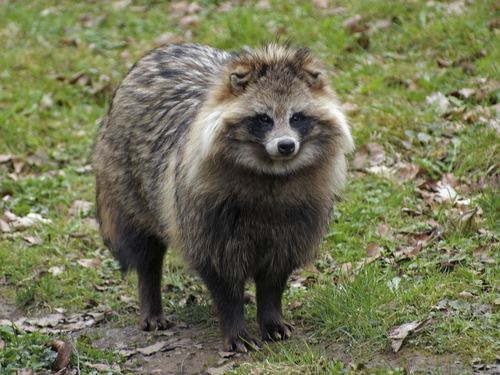
Researchers have suggested that they be considered a separate species, N. viverrinus, or that raccoon dogs of Japan could be further divisible into separate subspecies as N. p. procyonoides (hondo-tanuki) and N. p. albus (ezo-tanuki), but both views are controversial.
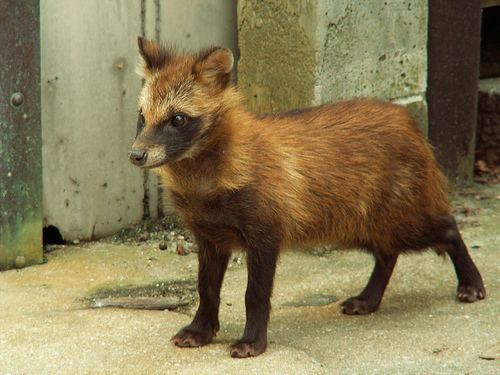
As the tanuki, the animal has been significant in Japanese folklore since ancient times. The legendary tanuki is reputed to be mischievous and jolly, a master of disguise and shapeshifting, but somewhat gullible and absentminded. It is also a common theme in Japanese art, especially statuary.
"Tanuki" is often mistakenly translated into English as "badger" or "raccoon" (as used in the US version of the movie Pom Poko and outlined in Tom Robbins' book Villa Incognito), two unrelated types of animals with superficially similar appearances. Traditionally, different areas of Japan had different names for raccoon dogs as animals, which would be used to denote different animals in other parts of the country, including badgers and wild cats; however, the official word in the standard Tokyo dialect is now "tanuki", a term that also carries the folkloric significance.
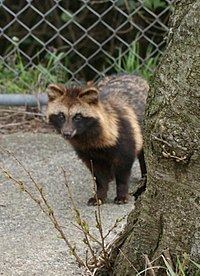
Name
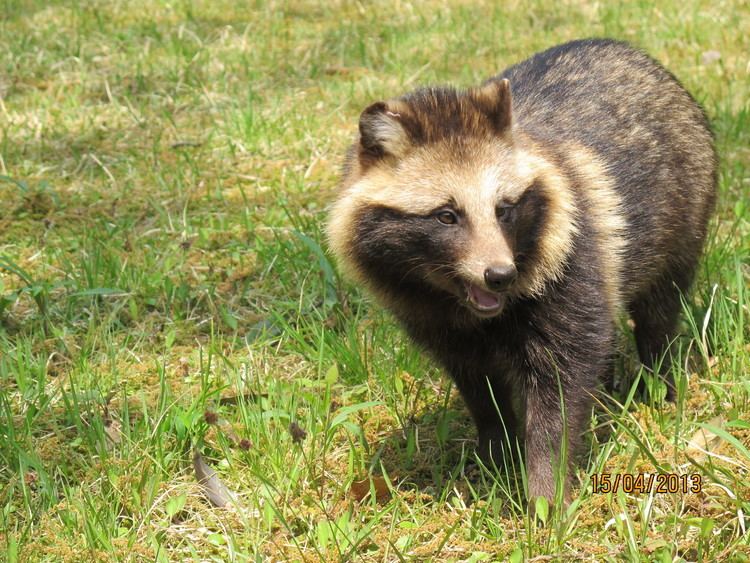
While tanuki are prominent in Japanese folklore and proverbs, they were not always clearly distinguished from other animals with a similar appearance. In local dialects, tanuki and mujina (狢, kyujitai: 貉) can refer to raccoon dogs or badgers. An animal known as tanuki in one region may be known as mujina in another region. In modern Tokyo standard dialect, tanuki refers to raccoon dogs and anaguma refers to badgers. Regional dishes known as tanuki-jiru ("tanuki soup") do not contain actual tanuki. Some northern, very rural communities may eat tanuki stew (tanuki shichuu).
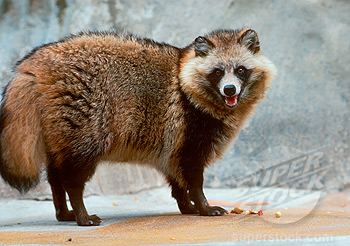
Originally, the kanji for tanuki, 狸 (kyujitai: 貍) was used to refer to other mid-sized mammals, mostly wild cats. Since wild cats live only in limited regions of Japan (e.g. Iriomote, Okinawa), the characters are believed to have begun being used to mean "raccoon dog" instead starting around the Japanese feudal era. This shift in meaning, along with the rarity of the raccoon dog outside Japan, may have contributed to confusion over the proper translation of tanuki into other languages.
In Japanese slang, tanuki gao ("raccoon dog face") can refer to a face that looks like that of the animal, or a person's facial expression of feigned ignorance. By contrast, kitsune gao ("fox face") refers to people with narrow faces, close-set eyes, thin eyebrows, and high cheekbones.
Taxonomic disputes
Some debate exists in the scientific community regarding speciation between the other subspecies of raccoon dog and the Japanese subspecies in that due to chromosomal, behavioral, and weight differences, the Japanese raccoon dog could be considered a separate species (i.e. Nyctereutes viverrinus rather than N. procyonoides viverrinus). The Japanese raccoon dog has a relatively smaller stomach and shorter fur of lesser insulation value than mainland raccoon dogs.
Genetic analysis has confirmed unique sequences of mtDNA, classifying the Japanese raccoon dog as a distinct isolation species, based on evidence of eight Robertsonian translocations. The International Union for Conservation of Nature (IUCN) canid Group's Canid Biology and Conservation Conference in September 2001 rejected the classification of the Japanese raccoon dog as a separate species, but its status is still disputed, based on its elastic genome.
A not mutually exclusive position advanced by some researchers is that raccoon dogs of Japan could be further divisible into separate subspecies as N. p. procyonoides (hondo-tanuki) and N. p. albus (ezo-tanuki).
Conservation and exhibition
The IUCN places the raccoon dog at "least concern" status due to the animal's wide distribution in Japan and abundant population, including as an introduced species throughout northeastern Europe. In many European countries, it is legal to hunt raccoon dogs, as they are considered a harmful and invasive species.
This species is rarely exhibited in zoological parks. For example, only two zoos accredited by the American Zoo and Aquarium Association – Zoo Atlanta in Atlanta, Georgia, and the Red River Zoo in Fargo, North Dakota – currently exhibit this species in the United States. The Hangzhou Zoo in China and the River Safari in Singapore also have Japanese raccoon dogs.
In folklore and tradition
The tanuki has a long history in Japanese legend and folklore. Bake-danuki (化け狸) are a kind of tanuki yōkai (ghost) found in the classics and in the folklore and legends of various places in Japan.
Although the tanuki is a real, extant animal, the bake-danuki that appears in literature has always been depicted as a strange, even supernatural animal. The earliest appearance of the bake-danuki in literature, in the chapter about Empress Suiko in the Nihon Shoki written during the Nara period, there are such passages as "in two months of spring, there are tanuki in the country of Mutsu (春二月陸奥有狢), they turn into humans and sing songs (化人以歌). ". Bake-danuki subsequently appear in such classics as the Nihon Ryōiki and the Uji Shūi Monogatari. In some regions of Japan, bake-danuki are reputed to have abilities similar to those attributed to kitsune (foxes): they can shapeshift into other things, shapeshift people, and possess human beings.
Many legends of tanuki exist in the Sado Islands of Niigata Prefecture and in Shikoku, and among them, like the Danzaburou-danuki of Sado, the Kinkyou-tanuki and Rokuemon-tanuki of Awa Province (Tokushima Prefecture), and the Yashima no Hage-tanuki of Kagawa Prefecture, the tanuki that possessed special abilities were given names, and even became the subject of rituals. Apart from these places, tanuki are treated with special regard in a few cases.
The character 狸, pronounced lí in modern Mandarin, was originally a collective name for medium-sized mammals resembling cats in China, with the leopard cat as its nucleus. When this character was brought to Japan, it could not be suitably applied to any animals. Japanese intellectuals used the character to signify tanuki, stray cats, wild boars, Eurasian badgers, weasels, and Japanese giant flying squirrels.
The tanuki of Japan from time immemorial were deified as governing all things in nature, but after the arrival of Buddhism, animals other than envoys of the gods (foxes, snakes, etc.) lost their divinity. Since all that remained was the image of possessing special powers, they were seen as evil or as yōkai, with tanuki being a representative type. Some also take the viewpoint that the image of the tanuki has overlapped with that of the mysterious and fearful 狸 of China (leopard cat). However, since the tanuki of Japan do not have the fearsome image that the leopard cats of China do, unlike in China, their image took the form of a more humorous kind of monster, and even in folktales like "Kachi-kachi Yama", and "Bunbuku Chagama", they often played the part of foolish animals.
Compared with kitsune, which are the epitome of shape-changing animals, one saying is given that "the fox has seven disguises, the tanuki has eight (狐七化け、狸八化け)". The tanuki is thus superior to the fox in its disguises, but unlike the fox, which changes its form for the sake of tempting people, tanuki do so to fool people and make them seem stupid. Also, a theory is told that they simply like to change their form.
The comical image of the tanuki having a large scrotum is thought to have developed during the Kamakura era, where goldsmiths would use the pelts of tanuki for the process of hammering gold nuggets into leaf. Due to the actual wild tanuki having disproportionately large testicles, a feature that has inspired humorous exaggeration in artistic depictions, and how gold nuggets share a homophone with testicles in the Japanese language, such associations would come to memetically link them together into its folklore image tradition of being a creature of wealth and whimsy. Tanuki may be shown with their testicles flung over their backs like travelers' packs, or using them as drums. As tanuki are also typically depicted as having large bellies, they may be depicted as drumming on their bellies instead of their testicles — particularly in contemporary art.
Bake-danuki by area
Stories of bake-danuki are told in each area of Japan, especially in Shikoku, and whenever mysterious events occur, it would be the work of a tanuki. There are also ones known internationally like the Inugami Gyoubu and his 808 followers of his household.
Ongoing popular tradition
A common schoolyard song in Japan makes explicit reference to the tanuki's testicles:
It continues for several verses, with many regional variations.
The legendary tanuki has eight special traits that bring good fortune, possibly created to coincide to the hachi symbol (八, meaning 'eight') often found on the sake bottles the statues hold. The eight traits are these:
The statues available all over Japan of the tanuki are Shigaraki ware, a style of pottery long associated with tanuki imagery. According to Alice Gordenker, the modern version of the tanuki was developed by a potter named Tetsuzo Fujiwara, who moved to Shiga Prefecture in 1936 and whose pottery was admired even by the emperor.
In popular culture
Tanuki are a recurring theme in Japanese popular culture. The first exposure of non-Japanese to tanuki often comes through exported Japanese media; however they are often described as "raccoons" in translation or assumed as such if no species is given.
Some notable appearances of tanuki in popular culture include these:
Tanuki often appear alongside kitsune. For example, in Pom Poko, kitsune are seen coexisting with human society as gangsters and prostitutes, in contrast to the tanuki who attempt to resist it; and in Animal Crossing, the player's town is sometimes visited by an unscrupulous kitsune art dealer named Redd. In Super Mario 3D Land, Luigi's equivalent of Mario's Tanooki suit instead resembles a fox. In Phoenix Wright: Ace Attorney - Dual Destinies, a nine-tailed fox of legend is also featured alongside themes of tanuki. In Kirby's Dreamland 3, the bosses of the third world are a large tanuki and kitsune. They also appear in Kirby: Right Back at Ya In Naruto, Gaara and Naruto, the holder of the Nine-Tails, are the only two jinchûriki to appear in the first part of the series, possessing tailed beasts that resemble a tanuki and a kitsune.
In Japanese cooking, the words "tanuki" and "kitsune" designate two varieties of the udon dish. Tanuki udon contains the flakes of fried tempura batter ("tenkasu"). Kitsune udon contains fried tofu ("abura-age").
